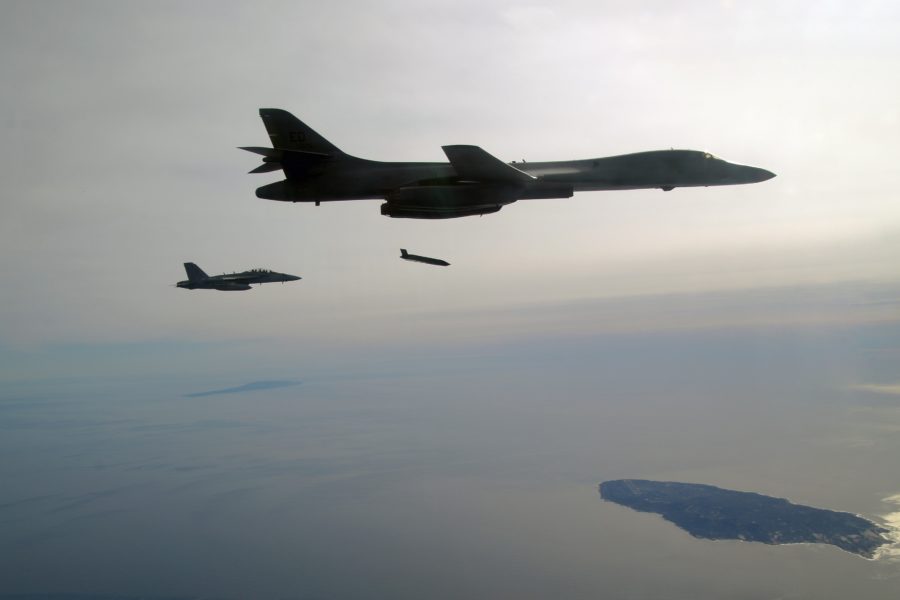Lockheed Martin has opened a second production line to make two of the Pentagon’s most in-demand weapons: the LRASM anti-ship cruise missile and the JASSM-ER air-to-surface variant.
Wargames have shown the utility of the missiles in countering a Chinese invasion of Taiwan. The problem is that the simulations also show that the stocks of AGM-158C LRASM and JASSM-ER from which it is adapted would be quickly expended in a conflict, putting pressure on the services to boost their modest inventories.
“I think one of the most glaring gaps in our portfolio is anti-ship weapons, especially air-launched ones, and LRASMs are particularly important since it gives you the ability to attack from standoff,” Stacie Pettyjohn, director of the defense program at the Center for a New American Security, told Air & Space Forces Magazine.
“For several decades, we got out of the ship-killing business,” Pettyjohn added. “You actually do have to invest resources in it.”
Department of Defense documents outlining its latest budget request stressed that its goal is to “maximize” its procurement of LRASM.
Right now, Lockheed Martin is producing north of 500 LRASMs and JASSMs a year for the U.S. military, and the defense giant says it is working to increase its current capacity so that it can produce roughly 1,000 LRASMs and JASSMs per year. To do so, the new Lockheed Martin facility has increased automation and made other improvements compared with the original production line, both of which are located in Troy, Ala.
“We were able to quickly bring the production line up to speed in order to meet the orders we’ve committed to our U.S. military partners,” Dom DeScisciolo, the LRASM business development lead at Lockheed Martin, told Air & Space Forces Magazine.
The DOD has placed “quite a requirement on Lockheed to increase that production rate substantially,” DeScisciolo said in earlier remarks April 3 at the Navy League’s Sea-Air-Space conference in National Harbor, Md.
The Air Force has mapped up an ambitious long-term plan to acquire LRASMs. The Air Force budget calls for buying just 27 of the missiles in fiscal 2024, with the Navy requesting 91. But the Air Force wants a multiyear procurement contract for LRASMs that would stretch to 2028. That would more than quadruple USAF yearly buys for around 380 additional LRASMs.
The U.S. military’s shift to the Pacific is the main reason for the focus on anti-ship weapons. But the lessons from Ukraine also loom large. Kyiv has been bolstered by massive munitions donations from the U.S. and Western allies, straining U.S. supplies.
“There is no constituency to support munitions during peacetime,” said retired Lt. Gen. David A. Deptula, the dean of the Mitchell Institute for Aerospace Studies. “I think Ukraine has kind of shaken the dust out of peoples’ eyes.”
But earlier conflicts also showed the need to maintain large munitions stocks. When the U.S. fought ISIS in Operational Inherent Resolve, it used an enormous quantity of precision-guided ordnance. A 2021 RAND report assessed that 115,983 weapons, mostly precision-guided munitions, were released in coalition airstrikes, and led to shortfalls in U.S. stocks of JDAM guided bombs and Hellfire missiles.
LRASMs and JASSMs have many common components and are made on the same production lines. “As the missiles come down the production line some are earmarked as LRASM, some are earmarked as JASSM,” DeScisciolo said. “They’re all sequenced through based on the demand of the customer.”
Lockheed Martin is now exploring using HIMARS mobile-missile launchers to launch LRASMs. The HIMARS launchers have been an enormous asset for Ukraine, which has used them to conduct so-called “shoot and scoot” precision fires against their Russian adversary.
“The concept of coupling the unique lethality and range of LRASM with the survivability of the combat-proven HIMARS for a ground-launch variant provides a powerful combination deployable in a variety of scenarios, including conventional and asymmetric warfare,” DeScisciolo said.
The company is also looking at other “next-generation” LRASM capabilities, he added. Lockheed Martin hopes to make LRASMs work with more aircraft too. Right now, the only aircraft that can launch the weapon are Air Force B-1 Lancer bombers and Navy F-18 Super Hornet fighters. But Lockheed Martin and the military are working on integrating LRASMs with the multi-service F-35 Lightning II fighter and the Navy’s P-8 Poseidon.
Deptula and Pettyjohn said that strengthening deterrence against China does not depend on a single missile and that cheaper and more diverse options are also important. LRASMs cost upwards of $3 million per missile, according to budget documents.
“We do need to find ways to buy larger quantities of more affordable weapons,” Pettyjohn said.
